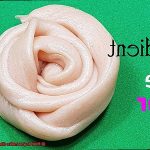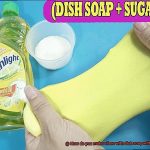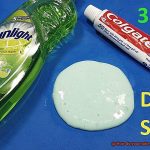Are you tired of staring at that pesky, dried glue clinging to your beautiful glass surface?
Ugh, we’ve all been there. Whether it’s the aftermath of a wild crafting session or an unfortunate spill, removing dried glue from glass can feel like an uphill battle.
But fret not, my friend. In this nifty guide, we’re diving headfirst into this sticky situation and exploring foolproof methods to rescue your glass from the clutches of adhesive doom.
From everyday household heroes to secret weapons in a bottle, we’ve got all the tricks up our sleeves. So grab your trusty cleaning arsenal and prepare to bid farewell to those unsightly glue remnants.
Get ready to unleash the power of our expert advice and restore your glass surfaces to their former sparkling glory.
Precautions and preparation before removing dried glue from glass
Contents
- 1 Precautions and preparation before removing dried glue from glass
- 2 Method 1: Using vinegar to remove dried glue from glass
- 3 Method 2: Utilizing rubbing alcohol to remove dried glue from glass
- 4 Method 3: Using adhesive removers specifically designed for glass surfaces
- 5 Dealing with stubborn dried glue on glass surfaces
- 6 Additional tips and tricks for removing dried glue from glass
- 7 Preventing future incidents of dried glue on glass surfaces
- 8 Common mistakes to avoid when removing dried glue from glass
- 9 Conclusion
Say goodbye to the frustration of dried glue on your beloved glass surfaces. Whether you’re dealing with a sticky mishap or the aftermath of a DIY project gone wrong, fear not. With the right precautions and meticulous preparation, you can effortlessly restore your glass to its original, dazzling state. In this comprehensive guide, we will lead you through the necessary steps to ensure a safe and effective glue removal process.
Put Safety First:
Never compromise on your safety when removing dried glue from glass. Shield your hands and eyes from potential harm by wearing protective gloves and safety goggles. These precautions are especially vital when working with adhesive removers or sharp tools that demand extra care.
Prioritize Ventilation:
Adequate ventilation is a must during glue removal. Opt for a well-ventilated area or open windows to promote fresh air circulation. Some adhesive removers release fumes that can be harmful if inhaled for prolonged periods, so ensure proper airflow throughout the process.
Test the Waters:
Before diving into the glue removal process, always test any adhesive remover or scraping tool on a small, inconspicuous area of the glass. This preliminary step will help determine the effectiveness and compatibility of your chosen method or product for your specific type of glue and glass.
Gather Your Arsenal:
To conquer dried glue on glass, arm yourself with essential tools in advance. Be sure to have a plastic scraper or putty knife, rubbing alcohol or nail polish remover, cotton balls or a soft cloth, warm water, dish soap, and a trusty microfiber cloth for cleaning up after.
Safeguard Surrounding Surfaces:
If there are other materials or surfaces near the glued area, such as painted walls or wooden frames, it’s crucial to shield them from any potential damage during the removal process. Utilize masking tape or plastic sheeting to cover and isolate these areas, ensuring a pristine outcome.
Decode the Instructions:
If you opt for a specific adhesive remover or solvent, embark on your glue removal journey by thoroughly reading and comprehending the instructions provided by the manufacturer. Each product may have distinct application methods and safety precautions, so acquaint yourself with the recommended usage guidelines for optimal results.
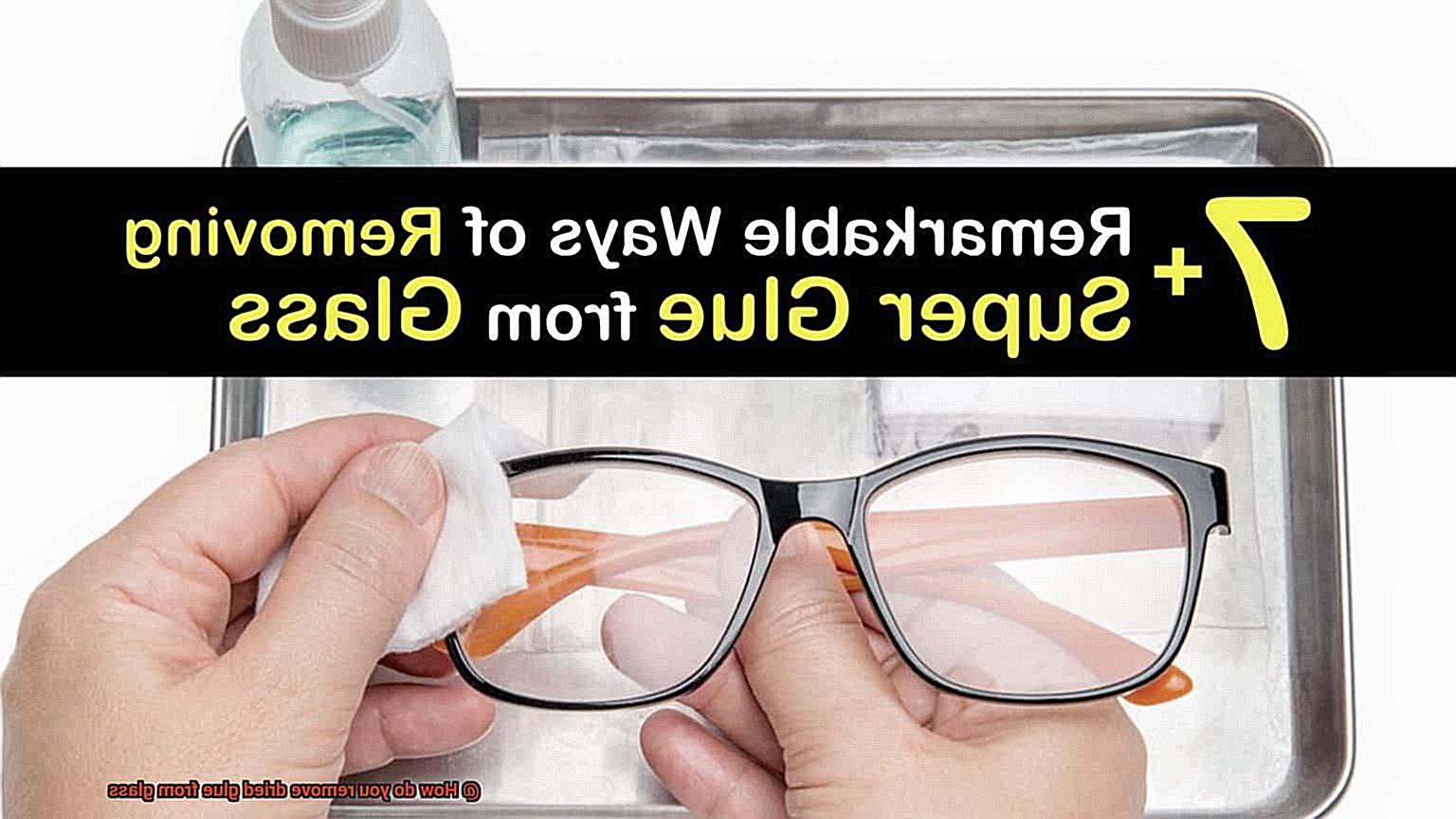
Patience is a Virtue:
Removing dried glue from glass demands patience. Rushing the process may result in scratches or other damage to the glass surface. Adopt a methodical approach, employing small, controlled motions that allow the adhesive remover or scraping tool enough time to soften and loosen the glue. Remember, a little patience guarantees a clean and glue-free surface.
Method 1: Using vinegar to remove dried glue from glass
Discover the secret to restoring your glass surfaces to their former glory with the incredible power of vinegar. In this comprehensive guide, we will take you through the step-by-step process of using vinegar to remove dried glue from glass. Say goodbye to those pesky adhesive stains and hello to pristine glass surfaces. Vinegar is not only a versatile and cost-effective household product, but it also offers a safe alternative to harsh chemicals. Let’s dive into this transformative method and watch as your glass shines brighter than ever before.
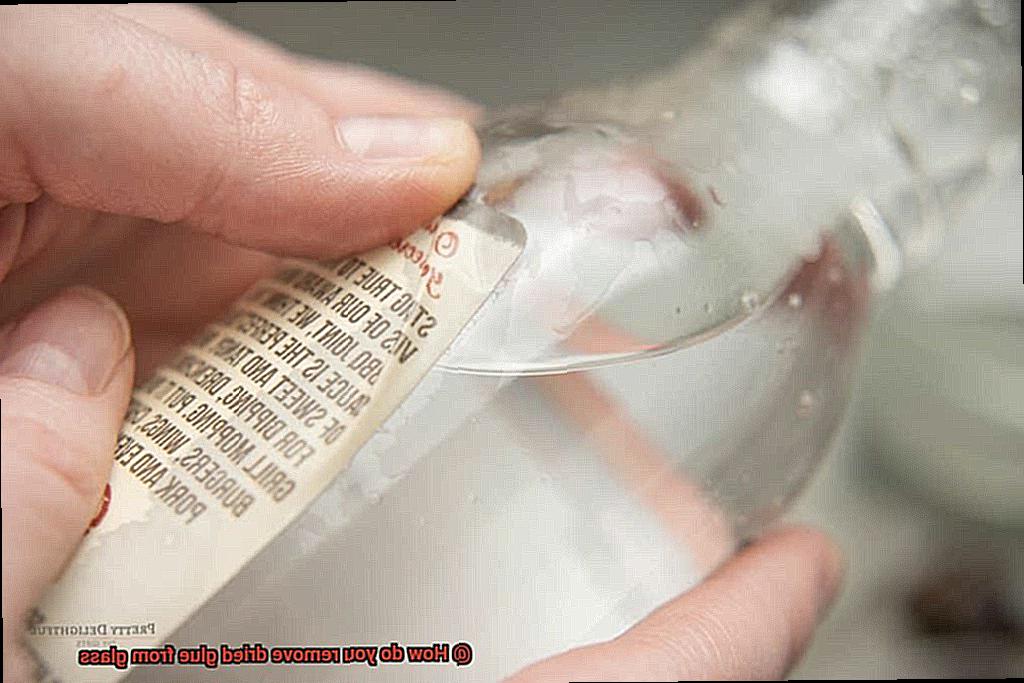
Step 1: Gather Your Supplies
Before embarking on this magical journey, make sure you have everything you need. Arm yourself with white vinegar, a trusty spray bottle, a soft cloth or sponge, and a plastic scraper or an old credit card. These readily available items can be found at your local grocery store or supermarket.
Step 2: Spray and Soak
Unleash the power of undiluted white vinegar by filling your spray bottle. Directly target the stubborn dried glue by liberally spraying the affected area until it’s well-saturated. Watch in awe as the vinegar penetrates and softens the adhesive, preparing it for removal. Patience is key here, so allow a few minutes for the magic to happen.
Step 3: Scrub Away
Armed with your trusty soft cloth or sponge, gently scrub the area. Feel the satisfaction as the vinegar works its wonders, loosening the tenacious grip of the glue from the glass surface. Be firm yet gentle, ensuring no harm comes to your precious glass.
Step 4: Get Scraping (if needed)
If the glue proves to be a formidable foe, fear not. It’s time to bring out the heavy artillery – a plastic scraper or an old credit card. Carefully wield your weapon of choice and scrape away the softened glue, all while safeguarding the integrity of your glass. Remember, slow and steady wins this battle.
Step 5: Repeat and Rinse
For those pesky remnants of glue that refuse to surrender, do not despair. Repeat the spraying and scrubbing process until every trace of dried glue vanishes. Once satisfied with the results, rinse the glass with water to bid farewell to any lingering vinegar residue.
Step 6: Dry it Out
In the final step, achieve a streak-free finish by grabbing a clean cloth and diligently drying the glass. Witness the transformation as watermarks fade away, leaving behind flawlessly pristine glass surfaces.
Method 2: Utilizing rubbing alcohol to remove dried glue from glass
Today, we embark on a new battle, armed with a secret weapon – rubbing alcohol. This mighty solvent holds the power to dissolve the adhesive properties of glue, allowing us to banish it from our precious glass surfaces with ease.
But first, let us gather our supplies. Prepare your arsenal with rubbing alcohol (isopropyl alcohol), cotton balls or swabs, a soft cloth or sponge, and warm soapy water. Now, let the battle commence.
- Step 1: Imbue your cotton ball or swab with the potent elixir of rubbing alcohol. Ensure it is saturated but not dripping – after all, we don’t want a messy battlefield.
- Step 2: With gentle determination, rub the soaked cotton ball or swab over the dried glue on the glass surface. Apply slight pressure and unleash circular motions. This is where the magic unfolds – the rubbing alcohol dissolves the glue, weakening its grip.
- Step 3: Persist in your efforts until every last trace of glue has been vanquished. Depending on the glue’s stubbornness, multiple cotton balls or swabs may be necessary. Do not surrender – remember, perseverance is our ally.
- Step 4: Once victory is achieved, cleanse the glass surface with warm soapy water to eliminate any residue left by the rubbing alcohol. Let our triumph be spotless and untainted.
- Step 5: Finally, dry the glass using a soft cloth or sponge. This crucial step ensures no streaks or water spots mar our hard-fought conquest.
And there you have it – a pristine and triumphant glass surface, liberated from the clutches of dried glue. Now you can proudly showcase your glassware or revel in crystal-clear windows without any unsightly adhesive stains.
Method 3: Using adhesive removers specifically designed for glass surfaces
Fear not. We have the ultimate solution to restore your glass to its pristine state. In this comprehensive guide, we will walk you through the process of effectively removing dried glue from glass using adhesive removers specifically designed for this purpose. With our step-by-step instructions and expert tips, you’ll have your glass looking flawless in no time.
Step 1: Gather the Tools:
To begin your glue-removal journey, make sure you have the following tools at hand:
- Adhesive remover: Acetone or rubbing alcohol
- Cotton balls or a soft cloth
- Plastic scraper or fingernail
- Mild glass cleaner
- Gloves (optional but recommended)
- Find a well-ventilated area for your glue-busting adventure.
Step 2: Test the Adhesive Remover:
Before diving into the world of adhesive removers, it’s crucial to test the product on a small, inconspicuous area of the glass surface. This step ensures that the remover won’t cause any damage.
Step 3: Using Acetone:
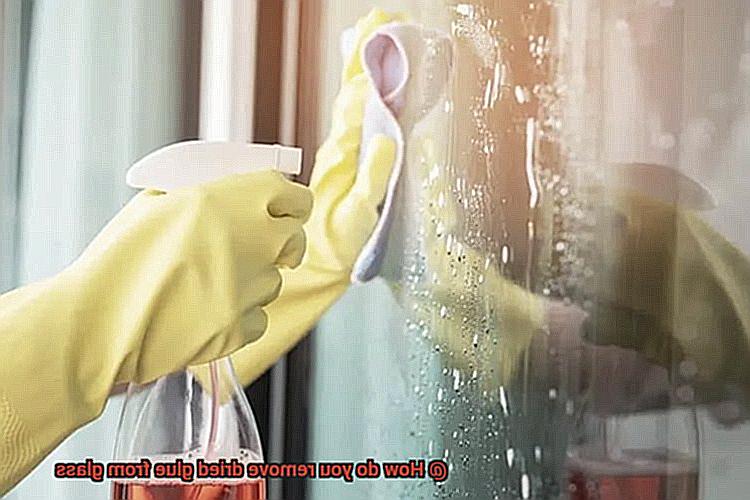
Let’s tackle that dried glue with some acetone magic:
- Soak a cotton ball or cloth in acetone.
- Gently rub it onto the dried glue, ensuring complete coverage.
- Allow the acetone to sit for a few minutes, letting it work its softening magic on the glue.
- With a plastic scraper or your trusty fingernail, gently scrape off the softened glue. Be cautious not to scratch the glass.
- Repeat the process if necessary until all traces of glue have vanished.
Step 4: Using Rubbing Alcohol:
For more delicate glass surfaces, let’s turn to rubbing alcohol:
- Soak a cotton ball or cloth in rubbing alcohol.
- Gently rub it onto the dried glue, covering the entire affected area.
- Give the rubbing alcohol a few minutes to weaken the adhesive.
- Employ your plastic scraper or fingernail to gently scrape off the softened glue. Take care not to damage the glass.
- If there are still remnants of glue, repeat these steps until your glass is flawless once more.
Step 5: Commercial Adhesive Removers:
If the dried glue remains stubborn and resistant to acetone or rubbing alcohol, it’s time to bring in the heavy artillery – commercial adhesive removers formulated specifically for glass surfaces. Follow the manufacturer’s instructions for optimal results.
Step 6: Clean the Glass:
Once you’ve successfully bid farewell to that pesky glue, it’s essential to give your glass surface a final touch:
Dealing with stubborn dried glue on glass surfaces
We have the ultimate guide to conquer this sticky situation. As masters of glue removal, we’ve compiled a comprehensive arsenal of techniques to help you banish that clingy adhesive once and for all.
Let’s start by understanding the different types of glue and their respective removal methods. Water-based glues, such as white or school glue, can often be vanquished with a simple concoction of warm water and dish soap.
Immerse a cloth or sponge in this magical elixir and gently scrub the glue until it begins to relinquish its hold. Rinse the glass with pure water and diligently dry it.
But what if the glue proves to be an indomitable foe? In such cases, it’s time to unleash the heavy artillery – a scraping tool. Whether it be a plastic scraper or an old credit card, exercise caution as you scrape to avoid wounding the glass. Aid the removal process by applying rubbing alcohol or acetone to a cloth and delicately rubbing away the remnants of the adhesive.
Now, let’s delve into the realm of stronger glues like epoxy or super glue. These formidable adversaries require a secret weapon – acetone. Arm yourself with a cotton ball or cloth doused in acetone and gently massage the glue until it surrenders. Ensure proper ventilation and safeguard your skin from contact during this battle.
If you seek an alternative approach, heat may prove to be your salvation. Grasp your trusty hairdryer or heat gun set on low and direct its scorching breath towards the dried glue. Witness as it softens under the relentless assault, making it pliable enough to scrape off with your plastic weapon or wipe away with a cloth.
But what if these methods fall short? Do not despair. Commercial adhesive removers specifically designed for glass surfaces await your command. Follow their instructions diligently and ensure adequate ventilation in the area.
Once you’ve triumphed over the tenacious glue, it’s time to lavish your glass with a thorough cleaning. Employ a glass cleaner or a mixture of vinegar and water to restore its lustrous sheen, banishing streaks and smudges.
Remember, safety is paramount. Don your protective gloves and eyewear when engaging in combat with solvents or scraping tools to ward off any mishaps.
Additional tips and tricks for removing dried glue from glass
We’ve all experienced it – a small mishap or a crafting project gone awry, leaving us with dried glue marring our precious glass surfaces.
As an expert in the art of glue removal, I am here to equip you with additional tips and tricks to tackle even the most stubborn glue stains. Get ready to restore your glass to its former glory.
The Heat is On:
Prepare to witness the transformative power of heat on dried glue. Grab your trusty hairdryer or heat gun and delicately warm up the glue. Caution is crucial here; avoid overheating the glass, as it may crack or shatter under extreme temperatures.
Vinegar Solution:
Unleash the dynamic duo of white vinegar and warm water in a spray bottle. Mix them in equal parts and spritz the solution onto the dried glue, allowing it to work its magic for a few minutes. Now, armed with a sponge or cloth, scrub away the softened glue.
The acidic nature of vinegar aids in breaking down the adhesive properties that bind the stubborn glue to your glass surfaces.
Rubbing Alcohol:
Harness the power of rubbing alcohol to dissolve dried glue with ease. Gently moisten a cloth or cotton ball with this potent elixir and massage it onto the affected area.
Witness how effortlessly the alcohol dissolves the glue, rendering it vulnerable to removal. Remember to test this method on a small, inconspicuous spot first to ensure it doesn’t cause any unwanted damage.
The Power of Lemon:
Embrace the zesty prowess of fresh lemon juice in battling those persistent glue stains. Squeeze out the tangy elixir onto the affected area and allow it to permeate for a few minutes. Armed with a sponge or cloth, scrub away at the weakened glue. Finish the process by rinsing with water to eliminate any lingering residue. The citric acid found in lemon juice acts as a formidable foe against the glue’s grip on your glass surfaces.
Baking Soda Paste:
Prepare a powerful concoction by mixing baking soda with a small amount of water, creating a potent paste. Apply this paste directly onto the dried glue, allowing it to sit and work its magic for 10-15 minutes. Armed with a gentle brush or cloth, scrub away at the softened glue. Finally, rinse with water to ensure a clean finish, free from any remnants of the glue’s former hold.
Razor Blade or Scraper:
For those persistent dried glue stains that refuse to yield to gentler methods, introduce them to the precision of a razor blade or scraper. Carefully hold the blade at an angle and gently scrape away the stubborn glue. Exercise caution to avoid scratching the glass surface while effectively removing thicker layers of dried glue.
Preventing future incidents of dried glue on glass surfaces
We have the ultimate guide to prevent future incidents of this sticky situation. In this blog post, we’ll share expert tips and strategies that will keep your glass surfaces clean and glue-free. From using protective coverings to employing precision applicators, we’ve got all the tricks up our sleeves.
Use protective coverings:
When working with glue near glass surfaces, it’s crucial to create a barrier between the two. Grab some plastic sheets or newspapers and lay them down as protective coverings. These shields will prevent accidental spills or drips from adhering to your precious glass.
Work in a well-ventilated area:
Ventilation is key when dealing with glue. Optimal airflow ensures quick drying and minimizes the chances of accidental contact with glass surfaces. Open those windows wide or set up some fans to let fresh air flow freely as you work your magic.
Opt for precision applicators:
Say goodbye to excess glue spills by using precision applicators. Fine-tip squeeze bottles and syringes allow you to control the amount of glue dispensed, reducing the chances of messes on your glass. Precision is the name of the game when it comes to adhesive application.
Clean spills immediately:
Accidents happen, but don’t let them ruin your glass surfaces. Act swiftly if you spill glue by using a clean cloth or paper towel to gently blot the spill. Be careful not to spread the glue further; a light touch is all you need. Remember, no rubbing or scrubbing allowed.
Don’t go overboard with glue:
Less is more when it comes to applying glue. Excessive amounts can drip onto your glass surface and create a messy situation. Use only the necessary amount of glue for your project, ensuring an even spread without any excess. Keep it precise and avoid glue overflow.
Handle glue with caution:
When handling glue near glass surfaces, exercise utmost caution to prevent spills or drips. Keep the glue away from the edges to avoid seeping onto the glass. And when moving or adjusting a glued item, do so gently and with care to avoid unintentional contact with the glass.
Common mistakes to avoid when removing dried glue from glass
There’s nothing worse than discovering dried glue clinging stubbornly to your beloved glass surface. But fear not. As an expert in the art of removing dried glue from glass, I’m here to guide you through the process and help you avoid common mistakes that can lead to disaster. So let’s dive in and uncover the dos and don’ts of glue removal from glass.
Steer Clear of Sharp Tools:
When faced with the tenacious grip of dried glue, it may be tempting to reach for a knife or blade. However, these sharp objects are a recipe for disaster, leaving behind unsightly scratches or even chipped glass. Instead, opt for safer alternatives like plastic scrapers or the trusty old credit card. These gentle tools will loosen the glue without leaving a trace.
Embrace Gentle Handling:
Glass is as delicate as a butterfly’s wings, requiring a delicate touch when removing dried glue. Applying excessive force can result in cracked or shattered dreams of a pristine glass surface. Take your time and apply gentle pressure when scraping off the glue, allowing the adhesive to surrender without causing harm. Remember, patience is a virtue.
Avoid Abrasive Cleaners:
In the quest for a spotless glass surface, one may be tempted to unleash the power of abrasive cleaners or scouring pads. However, these heavy-duty heroes can leave their mark in the form of unsightly scratches or discoloration on your glass. Instead, choose milder alternatives specifically designed for glass cleaning. A warm water and mild dish soap concoction will dissolve dried glue without harming your precious glass.
Prioritize Safety Precautions:
Removing dried glue may involve chemical warfare that could pose risks to your health and well-being. Be sure to prioritize safety by donning gloves and protective eyewear when working with these substances. Neglecting safety precautions is like walking a tightrope without a net, inviting personal injury or health issues. Remember, safety first, always.
Embrace the Virtue of Patience:
In a world that demands instant gratification, patience is often overlooked. Rushing the glue removal process is a recipe for disaster. Take a deep breath, follow the recommended steps and instructions, and allow the cleaning agents to work their magic. With gentle persistence and unwavering patience, you’ll achieve a successful removal without any damage.
i7gb0BQZmVA” >
Also Read: How to Remove Glue From Mirror?
Conclusion
Removing dried glue from glass can be a frustrating task, but with the right techniques, it is possible to restore your glass surfaces to their former glory. One effective method is to use a combination of heat and scraping. Start by heating the glue with a hairdryer or heat gun until it softens. Then, carefully scrape away the softened glue using a plastic scraper or an old credit card. Be gentle to avoid scratching the glass.
Another option is to use solvents such as acetone or nail polish remover. Apply a small amount of solvent onto a clean cloth and gently rub it onto the dried glue. Let it sit for a few minutes to allow the solvent to penetrate the glue. Then, using a clean cloth or sponge, wipe away the softened glue.
If these methods don’t work, you can try using vinegar or lemon juice. Soak a cloth in either vinegar or lemon juice and place it over the dried glue. Let it sit for some time to allow the acid in these substances to break down the adhesive properties of the glue. Afterward, gently scrub away the softened glue using a sponge or cloth.
Remember to always test any cleaning solution on a small, inconspicuous area of the glass before applying it to larger areas. This will help ensure that there are no adverse reactions or damage to your glass surface.
In conclusion, removing dried glue from glass requires patience and careful techniques. By using heat and scraping, solvents like acetone or nail polish remover, or natural remedies like vinegar or lemon juice, you can successfully remove stubborn adhesive residue from your glass surfaces.


